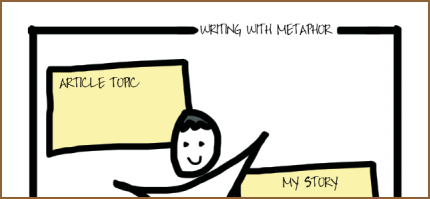Why it’s Never the Easy Metaphor
By Jessica Albon

Struggling to come up with the right stories for your newsletter? You’re not alone.
You know it’s important to share personal stories, but may not be quite sure what that should look like. You know it’s not enough to simply relay the story of the super cute thing Toby did this weekend, and think you should try to link it into your main story somehow… But, how?
One trick of expert writers is to use metaphors. But, these aren’t exactly the metaphors you were taught to use in school (e.g. “All the world’s a stage, and all the men and women merely players; they have their exits and their entrances.”). You’re not looking to write just a single sentence or two about your metaphor.
Rather, you’re going to use two advanced techniques to improve your use of metaphor (and really improve your articles).
So, let’s say that this weekend, Toby really improved at rollerblading, you could write about how the perseverance paid off, how his weekly practices have led to his being much faster than you’d expect for his age.
That would be a way to use your metaphor all throughout your article, building on the theme of perseverance.
But, the trouble with this approach is that it’s only one step above writing the one-sentence metaphor you learned about in school. And we want to take this technique into advanced territory.
By taking your metaphor structure into advanced writing territory, you make it all the more clear to your readers that you are the expert–because, when you write in expert ways, readers are better able to see the depth of your knowledge.
So, we’re not going to be satisfied merely with this intermediate metaphor level. We’re going to take it two steps further.
First, your perseverance metaphor is pretty obvious, isn’t it? After all, we all know that kids are masterful at learning new things through practice and that that’s a skill that we sometimes forget as adults. You’ll see a similar theme carried through dozens of articles. That makes it the “easy” metaphor. And, sure, as you’re first learning to use this technique, reaching for the easy metaphor makes sense.
But, the only way to truly master this technique is by taking it beyond these first steps.
Once you’ve mastered the art of linking your “easy” metaphor to your article, you have two more steps to master:
1) Going beyond the easy metaphor.
2) Weaving the metaphor into the story.
When you’re first learning to go beyond the easy metaphor, there’s one simple trick to do it right. Sit yourself down with a pad of paper and brainstorm 15 potential metaphors in the story you’re going to link to your article. (This story, by the way, can be about anything–from your family to your work with clients to that workshop you attended this weekend, etc, etc.)

Don’t stop short of 15–it’s absolutely, positively crucial that you make it all the way to the end. Don’t edit your ideas, just write from 1 to 15 without stopping.
Once you have all the ideas down, go over your list and cross out any that are “easy”–any that are obvious or that just about anyone could link to the topic of your article. Look over what remains. You’ll probably have 7 metaphors that go beyond what’s easy. In fact, one or two of your metaphors may seem all but impossible to link with your topic. For now, ignore any that seem impossible (though, when you’re ready to really improve your skills here, dive in with these “impossible” metaphors) and aim for one that’s in the middle. Choose the one that appeals to you and you’ve got your metaphor for today’s article.
After you’ve practiced going beyond the easy metaphor for awhile, you’ll be ready to really integrate this writing skill. You’ll integrate it by weaving your metaphor into the story.

Integration is much easier than it sounds, and here’s how I do it. I start with a piece of paper that has my topic and my metaphor written across the top. Then, I start brainstorming all the words that relate to my metaphor. So, for instance, using that easy metaphor of Toby learning to rollerblade, we’d list verbs, adjectives, and sensory words that relate to rollerblading. Words like “whiz” and “scrape.” Aim for as many words as possible–when it comes time to write your article, you’ll really appreciate having so many choices.
Once you have your list of words, write your article, sprinkling your words throughout. When you need an action word, try to use one of your rollerblading verbs. When you’re describing something, describe the parts that are similar to rollerblading with the adjectives on your list.
You’ll find that integration gets much easier with practice, so if your first few articles come slowly, don’t let that stop you–keep weaving your metaphor throughout your article. That practice will really pay off in richer, more meaningful articles that your readers are much more apt to keep and share with friends.
By stretching beyond the easy metaphors, and using your metaphor to make your article richer by weaving it throughout, effortlessly zooming your newsletter ahead of the competition.
Resources:
- Finding Your Metaphor (free PDF download)
- Integrating Your Metaphor (free PDF download)
- The Newsletter Spa for more interactive writing exercises like this one.






